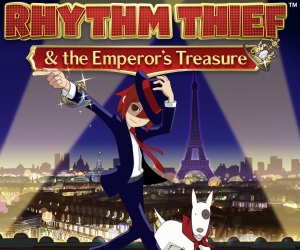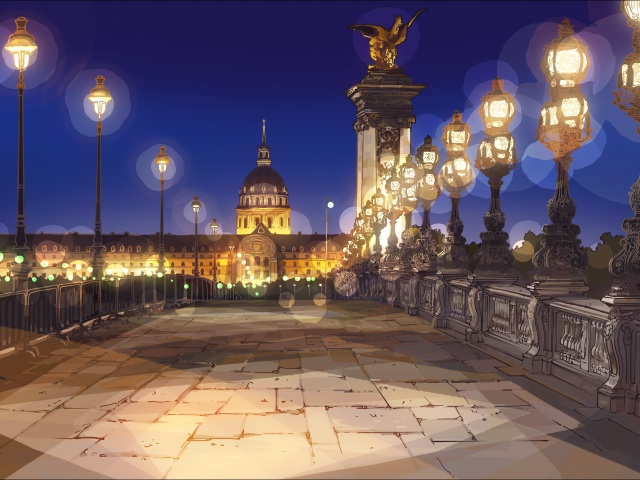Rhythm Thief & the Emperor’s Treasure Review
 Game: Rhythm Thief & the Emperor’s Treasure
Game: Rhythm Thief & the Emperor’s Treasure
Developer: SEGA
Publisher: Nintendo
Available on: Nintendo 3DS Only
There have been some surprising titles for the 3DS, little gems that have come from out of nowhere and delighted handheld gamers, even if they are limited or flawed in some way. Steel Diver was perhaps the strangest launch title I can think of, ever, but will always have a special place in my heart for the “Up Yours!” way Nintendo decided to roll with an oddball submarine game as a way to show off their new console. Crush3d was a clever remake of an ace puzzler from yesteryear, perfectly suited to the format. Ninja master Musashi was brought back to life with the hardcore, superbly animated Shinobi reboot. And now SEGA have decided to drop Rhythm Thief, a marriage of Professor Layton-style point and click exploration and fun rhythm action games.
Both genres are perfect fits for handhelds. Look at some of the terrific names from pocket-sized gamings past: Osu! Tatake! Ouendan!, Rhythm Heaven, Phoenix Wright, and more, but this is the first time the two styles have been fused together. It was crafted by former members of Sonic Team, who, of course, were responsible for their own excellent maraca-shaking musical fun-fest, Samba De Amigo. With Rhythm Thief containing some knowing, piss-taking nods to the crazy monkey shake ‘em up, and indeed SEGA’s other big dance concern Space Channel 5; is this bonkers mash up any good, or is it murder on the dancefloor?

STORY: A likeable protagonist is always a good start with any story-driven game, and young Raphael, who leads a nocturnal double life as debonair thief Phantom R, is just that. Phantom R is the scourge of the Paris Gendarme, with his penchant for stealing, and then replacing renowned works of art. With his dog Fondue, Raphael embarks on a mission to find out what happened to his father, who vanished a few years previously. All that young Raphael has to remember his pops by is a coin he left behind, which is emblazoned with a mysterious (and, it has to be said, very Triforce-like) symbol. When he one day spots some jewellery on display in the famed Louvre bearing the same crest, he sets out to pilfer it and unlock the mystery behind his old man’s disappearance. Along the way he meets up with a beautiful, violin-playing young lady called Marie, has to avoid the attentions of the pursuing coppers, and comes across a malevolent nemesis, claiming to be none other than historical French military leader and Emperor, Napoleon Bonaparte.
GRAPHICS: Paris comes to life in gloriously stylish animé style. You cannot possibly play this title and not think: “Level-5!”. Raphael and his cute dog are brilliant, charismatic creations, and there is a superb rogues gallery of other characters to interact with along the way. The hand-drawn backdrops are as beautiful as anything to have emanated from a Prof. Layton game, and there are some first-class animated cutscenes. Being a 3DS title, there are some stereoscopic effects that give depth to the backdrops, and work particularly well during the dance-off sections, where the camera zooms around a lot.
It is a lovely looking game, with an art style that suits the gameplay perfectly.
SOUND: The superb aesthetics are not limited to the visuals. The sound design is absolutely spot-on, with some funky tunes, excellent speech and innovative use of sound effects. Joining the excellent original compositions are some tunes from proper artists, including a terrific ending theme courtesy of Japanese Francophile warbler Kahimi Karie.

GAMEPLAY: Raphael is controlled in two ways during the exploratory parts of the game. You can move him around the city of Paris using the D-pad to travel around a handy map which is on the top screen of the clamshell. Once you enter a location, you can use the stylus to tap your environment and speak with other characters, enter doorways or go down different pathways, and to hunt down the hidden medals and musical notes, and to record sounds. Medals are the in-game currency, and can be used to purchase new movies, minigames and other unlockables.
Progress is achieved by solving puzzles, or defeating one of the numerous rhythm action-based minigames that form the meat of the game. Most of the puzzles are pretty basic stuff, such as a Simon Says style memory game or odd-one-out teasers, but the aforementioned sound recording plays a big part too. Sometimes, when you tap on the scenery, the sound of that particular object (or in some cases, animal) can be recorded and then used at a later date. Early on, you have to record the sound of a sleeping security guard snoring in order to pass through a voice-recognition security door. A little later on, you will record the sound of a growling bulldog to put the fear of god into a dog-phobic member of the Old Bill.
The rhythm action games are far more substantial. There are dance battles where you have to use well-timed sweeps of the stylus or draw circles in time with the music. At one point you use the gyro-controls to help Fondue catch falling items of grub in his eager maw. Raphael escapes from the feared roller-skate division of the Paris Police using deft presses of either A or B to jump and slide across the night-time rooftops of the French capital. There are scenes where you have to fend off henchmen using button presses, and even an encounter with a rather aggressive soccer player. One early stage uses taps of the lower screen to hide behind various differently shaped statues as you creep through the Louvre. All of the games are, of course, set to music, and the gameplay is always based around keeping in time with the beat, with the aim to achieve the perfect score on each stage.

LONGEVITY: Short and sweet would be an apt way to describe this game, the main story is easily conquered in a few hours, but this is true of most games in the rhythm/dance mould; nobody put 80 hours into Um Jammer Lammy, but it was still charming, and excellent. There are a few extra modes to play with after the main event is done, a gnarly mode which puts you up against a gauntlet of minigames with a set number of lives is challenging and fun, and there are some Streetpass opportunities to battle other 3DS owning opponents. There are lots of little hidden items and bits and bobs to collect along the way too, and you can eventually unlock a hard version of the story mode, which ramps up the difficulty of the stages quite significantly. There is much fun to be had in replaying the mingames and bettering your scores.
VERDICT: SEGA may be struggling financially, with many in-development games being canned and folks losing their jobs, But Rhythm Thief shows that they can still produce a damn good game when they put their minds to it, marrying some great narrative work with fun, diverse gameplay and, in Raphael, a potential breakout star in the making. It is pretty short lived, and as with many other examples, the gyro-controlled games are sometimes a bit hit and miss in terms of accuracy when compared to the smoother traditionally controlled fare, but don’t let this put you off, this is a terrific outing that works wonderfully well on the go.





